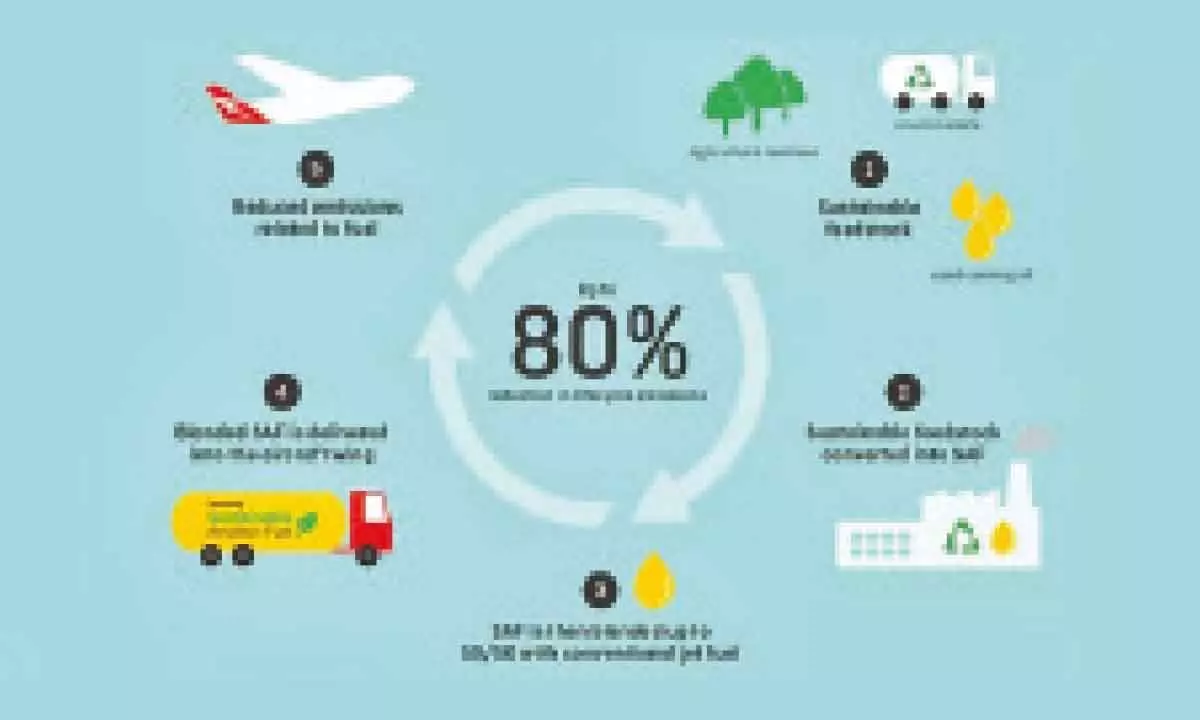Aviation thrives despite staring at an uncertain future
Production of sustainable aviation fuels (SAF) must increase thousand-fold to meet likely demand in 2050
image for illustrative purpose

To achieve net zero CO2 emissions in 2050, almost all the global roadmaps suggest that the aviation sector will need help from market-based measures and carbon removals to address the residual emissions
Aviation is committed to net zero carbon emissions by 2050, including the air cargo sector. At the World Cargo Symposium, Marie Owens Thomsen, IATA’s Chief Economist and SVP, Sustainability, put this challenge into context.
In 2023, the world produced some 37.4 gigatons of CO2, 59 gigatons including all greenhouse gases. Aviation’s share of this is just two per cent while transport’s total contribution is 23%. Transport’s CO2 output comes mainly from road vehicles, which produces more than 70% of its total, followed by shipping.
Sustainable aviation fuels (SAF) will be the primary tool, but efficiency gains, hydrogen power, and carbon removal technologies are among the many other initiatives that will need to play an important role.
The demand side of SAF is proven with airlines already purchasing every drop ever produced while forward agreements total close to $50 billion. The challenge is on the supply side. SAF production must increase a thousand-fold to meet anticipated demand in 2050, going from some 0.5 million tons today to 500 million tons.
Most of the oil and gas industries’ money goes on investment, such as new drilling, debt repayment, and dividends. Less than 3% is spent on renewable fuels. Moreover, aviation fuel is just 8% of refinery output.
In 2023, some $800 billion was invested in oil and gas, which is estimated to be twice the necessary amount to meet their needs. In contrast, aviation’s energy transition requires about $150 billion a year or just 19% of what the oil and gas industries get. In short, the oil and gas industries could do a lot more to help air transport transition to renewable energy.
As SAF production ramps up, air cargo can continue to reduce its CO2 emissions through new fleet. The average age of the cargo fleet is 25 years, almost twice that of the passenger sector. This is delaying CO2 reduction as older aircraft burn more fuel and so produce more emissions.
Improvements can also be made in single-use plastics (SUP), such as plastic covers, bubble wrap, labels, and pouches to name but a few. Fortunately, an IATA survey reveals that 42% of air cargo stakeholders have already adopted reusable alternatives to SUP.
Possible pathways to net zero CO2 emissions by 2050 differ significantly and depend on key assumptions of the authors regarding how decarbonization technologies and solutions may evolve. Depending on these assumptions, the resulting role of particular levers in aviation’s decarbonization will be more or less important.
All roadmaps assume that Sustainable Aviation Fuels (SAF) will be responsible for the greatest amount of CO2 reductions by 2050.
The role of SAF varies from 24%-70% (with a median value of 53%). This wide range reflects the uncertainties regarding potential supportive government action, the level of investments, cost of production, and profit potential, as well as access to feedstock.
Technology and operational efficiency improvements are expected to have a similar role in the net zero transition across the roadmaps, together contributing to about 30% of the emissions reduction in 2050 in all scenarios.
The estimated emissions savings by hydrogen and battery-powered aircraft vary greatly across the roadmaps, depending on whether a strong pro-hydrogen policy is adopted, and on whether there is a rapid decline in renewable energy prices, enabling swifter uptake of electricity-based technologies.
To achieve net zero CO2 emissions in 2050, almost all the global roadmaps suggest that the aviation sector will need help from market-based measures and carbon removals to address the residual emissions in 2050. Even if carbon removal technologies are considered an ”out-of-sector” mitigation measure, it is still both urgent and critical to develop these technologies as CO2 will be needed as feedstock for producing power-to-liquid (PtL) fuels.
“The Aviation Net Zero CO2 Transition Pathways Comparative Review demonstrates that there are multiple levers that can be used in different combinations to achieve the objective of decarbonizing aviation by 2050. All these levers will be needed in aviation’s transition. While the impact of each varies across the roadmaps, all roadmaps expect the greatest decarbonization in 2050 to stem from SAF. This report provides airlines, policymakers and all stakeholders with a useful tool to analyze and improve their policy, investment, and business choices. It is particularly important for SAF where strong and urgent public policy support is needed to increase production. Without that, no version of the roadmaps will get us to net zero carbon emissions by 2050,” said Marie Owens Thomsen, IATA’s senior vice-president (Sustainability) and Chief Economist.

